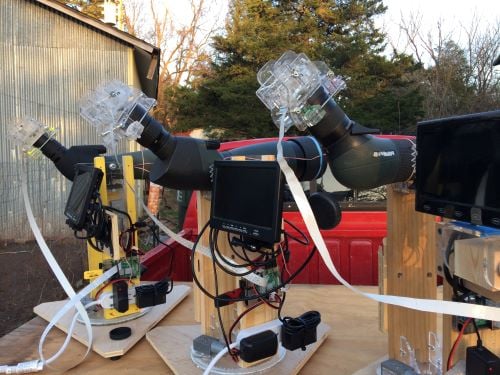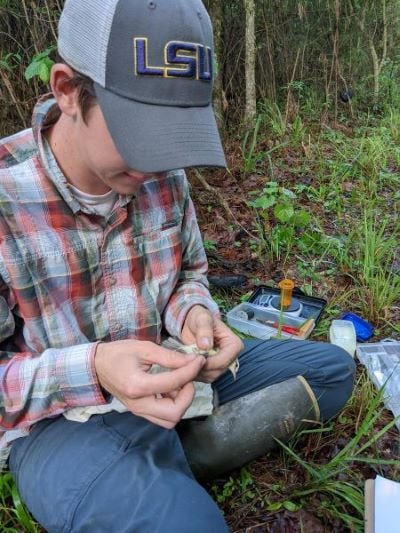Bird of Passage: May 2024
If you’ve read my book, you may remember the chapter on “moon-watching” as a method for gathering data on night-migrating birds and the small group of researchers trying to update this technique for the modern era. You might also recall Garrett Rhyne, the Louisiana grad student I shadowed in the field as he recaptured geolocator-tagged Swainson’s Warblers to download tracking data from the devices they’d carried on migration. New studies related to both of these projects were published earlier this year, so I thought this would be a great time for an update.
First, moon-watching: This method of using a telescope to count the silhouettes of night-migrating birds passing in front of the moon, a means of calculating the local “migration traffic rate,” fell out of vogue after the 1950s as weather radar was developed as a tool for studying large-scale migration patterns. But a few folks have never fully given up on it, and I wrote briefly in chapter two of my book about the LunAero project, an attempt to bring moon-watching into the modern age by automating it using motorized spotting scopes and video cameras.

Well, it looks like this effort is starting to pay off. In January, Eli Bridge, Wesley Honeycutt, and their colleagues published a study using the LunAero system to look at the social behavior of these nocturnal migrants. They found that while detecting groups of birds flying together was very rare (the percentage of birds in groups was never higher than 10%), birds were more likely to be traveling together in spring than in fall, and at the beginning and end of the night rather than in the middle. It’s a clever way to gather data on hard-to-study behavior.
Second, those Swainson’s Warblers: Accompanying Garrett Rhyne in the field was one of the highlights of my research for the book, and in chapter six I recounted following him through a Louisiana swamp as he attempted to locate and recapture warblers that he’d tagged with geolocators, tracking devices that the birds had since carried to their wintering grounds and back.

Garrett mentioned to me at the time that he was experimenting with a new type of geolocator that also recorded barometric pressure, and he and his colleagues published a very cool paper in February exploring what they were able to learn from those devices. Amazingly, if you have access to sufficiently detailed weather records, you can get a pretty accurate history of a bird’s movements based solely on the subtle variations in atmospheric pressure it’s experienced. This revealed incredible detail about the migratory journey of one of Garrett’s warblers, which flew from Virginia to Cuba and back while making use of a number of specific stopover sites along the way.
The curse of writing a popular science book is that it’s inevitably going to be out of date before it’s even published, but I’m really enjoying keeping up with the careers of all of the amazing scientists I met while working on Flight Paths!
Words About Birds
The Cornell Lab of Ornithology magazine asked me to cover some research suggesting that American Redstarts can speed up their spring migration to make up time if poor conditions on their wintering grounds lead to a late start. This is sort of good news, because it means they may be able to adapt as climate change leads to drier conditions in their winter home in Jamaica (which means less insects, which means less warbler food). But there’s a catch: Birds that leave late are also less likely to return the next year, suggesting that the effort required to migrate faster may cost them and lead to higher mortality down the road.
For The Revelator, I wrote about two recent studies that reveal the hidden interconnections between environmental change and birds' genetic code. Gene flow — the transfer of genetic material that results from interbreeding between populations — has helped endangered Southwestern Willow Flycatchers in San Diego, endowing them with new genetic variants that may help them better withstand climate change. For special saltmarsh-adapted Savannah Sparrows dealing with habitat loss, however, it’s a different story: Here, gene flow from inland populations is diluting their special adaptations for life in a saline environment.
Having written multiple stories about aspects of chickadee cognition (more on this soon!), I was intrigued by new research digging into just how Black-capped Chickadees’ amazing spatial memory works. These researchers found that “each time a chickadee hides a seed in a specific location, a unique brain pattern appears in the hippocampus.” When the chickadees in the study went back to retrieve their seeds later, tiny probes in their brains picked up the same pattern appearing again for each seed. The research describe this as a chickadee’s brain creating a unique “barcode” for the hiding place of each seed. Fascinating!
Jumping back in time a few million years: Here’s a fun paper exploring how “terror birds” — enormous, flightless, predatory birds that roamed South America prior to the last ice age — got to be so, well, terrifying. This was a big family of birds that included species ranging from three feet to ten feet (!) tall. Apparently their evolution was driven by factors including the emergence of greater areas of open habitat, providing new ecological niches to be exploited, and the need to avoid directly competing with one another, spurring some species to grow larger and larger over time so that they could focus on bigger prey than their cousins.
Finally, you may have heard that the body shapes and sizes of bird species around the world are shifting in response to climate change? Here’s a new wrinkle: This can can affect their songs. A study of 163 honeyeater species found that they’ve been getting smaller over time (the exact mechanism behind this isn’t well understood), and because smaller bodies mean smaller vocal tracts, the accelerating shrinking trend means that these birds are now singing higher-pitched songs than they used to. We don’t know exactly what this might mean for the birds, but the researchers behind the study think it could affect how they claim territories and attract mates.
Book Recommendation of the Month
Hummingbird Salamander by Jeff VanderMeer. Yes, I am branching out and recommending a work of fiction this month! This unique 2021 novel set in the near future follows an unnamed protagonist who gets sucked into a dangerous conspiracy after a mysterious stranger leaves her a very odd gift: a taxidermied hummingbird, from a (fictional) species believed to be extinct. Jane, who has never paid attention to the natural world before, is awakened to the biodiversity crisis even as she’s thrown into a bizarre world involving ecoterrorism, espionage, and murder.
Upcoming Events
May 3: *In-person* keynote at the Grays Harbor Shorebird Festival in Hoquiam, WA
May 18: *In-person* keynote at the Leavenworth Spring Bird Fest in Leavenworth, WA
May 20: Teaneck Public Library Eco Book Club (virtual)
Looking for a speaker (in person or virtually) for an event this summer or fall? Email me here!
Thanks for reading Bird of Passage! If you're reading this online or were forwarded it by a friend, subscribe for free to receive new posts via email and support my work.
Add a comment: